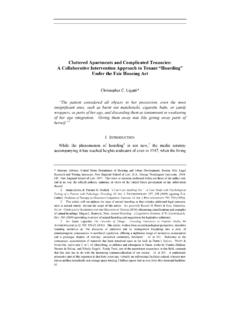Transcription of Massachusetts Standing Laws and Zoning Appeals: …
1 LIDINGTON_NOTE_WDFF Massachusetts Standing Laws and Zoning Appeals: Standing on Shaky Ground After Kenner v. Zoning Board of Appeals [N]early all the residences are built along the water front of said bay, and facing east, commanding a beautiful view of said bay .. and its real estate derives almost its whole value from this fact, and from its commanding view of the waters of [the] sound, and the fact that cool breezes which habitually and daily blow .. over this sound, and thus reach the residences.
2 And [provide] relief from summer I. INTRODUCTION Zoning laws in the United States came into existence at the turn of the twentieth century and were deemed constitutional under state police Since Zoning s inception, states have delegated the bulk of Zoning authority to local municipalities, and accordingly, this area of the law is quite The manifold nature of Zoning is strikingly evident at the judicial-review level, where courts grapple with upholding Zoning s legal underpinnings.
3 While at the same time maintaining deference to local The interplay between state and local authorities results in a body of law that can be, at times, contradictory and To have Standing to oppose an act of a local Zoning board, Massachusetts law requires a person to be aggrieved ; however, courts attempts to define aggrievement have yielded inconsistent Recently, in Kenner v. Zoning 1. Quintini v. Mayor of Bay St. Louis, 1 So. 625, 625-26 (Miss. 1887). 2. See Vill.
4 Of Euclid v. Ambler Realty Co., 272 365, 387 (1926) (declaring state Zoning laws constitutional under state police power). 3. See MASS. GEN. LAWS ANN. ch. 40A, 1A (West 2013) (authorizing cities and towns to adopt Zoning ordinances and by-laws in Massachusetts ); JOHN R. NOLON ET AL., LAND USE AND COMMUNITY DEVELOPMENT: CASES AND MATERIALS 140-47 (7th ed. 2008) (highlighting local Zoning authority per state-enabling statutes and multifaceted nature of Zoning ). 4. See NOLON ET AL.
5 , supra note 3, at 1135-67 (noting complex issues resulting from multiple layers of authority). 5. See id. 6. See ch. 40A, 17 (granting judicial review to [a]ny person aggrieved ); see also Daniel P. Dain, New SJC Standing Decision Raises Bar for Abutter Zoning Appeals, REBA NEWS, July 2011, at 1, 6, (DPD).pdf (concluding Massachusetts case law regarding Standing inconsistent and unpredictable); William V. Hovey & Michael Pill, Zoning Appeals: Where Do We Stand?
6 , MASS. LAW. WKLY., July 25, 2011, at 13 (analyzing current confused state of Massachusetts Standing laws). Within the context of Zoning , Standing is a critical issue: [F]or lawyers who represent property owners and real estate developers, the question of Standing may be as important as the 604 SUFFOLK UNIVERSITY LAW REVIEW [Vol. XLVI:603 Board of Appeals,7 the Massachusetts Supreme Judicial Court (SJC) attempted to clarify the standard, but only managed to further shroud Standing laws in confusion and In essence, the SJC raised the bar for threshold Standing determinations, and in doing so, utilized vague and imprecise language in defining In addition, the SJC created potential disruption in the well-settled area of the law of particularized The SJC articulated its new standard against the backdrop of a common occurrence in Massachusetts .]
7 An abutter opposing a special permit granting a structural-height increase that will effectively block scenic First determining that the local bylaws at issue do not protect view-based harms, the court went on to hold that the new standard for determining Standing requires that [t]he adverse effect on a plaintiff must be substantial enough to constitute actual aggrievement such that there can be no question that the plaintiff should be afforded the opportunity to seek a remedy. 12 In addition, the SJC erroneously asserted that in order to achieve Standing , a party must not only show that the view-based harm is particularized and specific to her property, but also that the community is harmed as Requiring a showing of community harm expressly contradicts the well-settled rule that a plaintiff must offer evidence of harm particular to her not shared by the terms of a major lease or the provisions of financing documents.
8 Edward S. Hershfield, Standing in Zoning Cases: Marashlian v. Zoning Board of Appeals of Newburyport, BOS. ( 1997) at 14, 14. In addition, principles of Standing implicate concepts of judicial efficiency: Although a plaintiff s Standing to sue is only a preliminary issue to be decided by the court, its importance as a doctrine of judicial economy is significant in Zoning cases. Timing is a crucial factor to the development of property. Without giving some authority to the courts to dismiss Zoning appeals cases for want of Standing , applicant property owners, although ultimately prevailing in court, will suffer in the end.
9 Communities in need of development will also suffer. Ross D. Cohen, Note, Why Require Standing If No One Is Seated? The Need to Clarify Third Party Standing Requirements in Zoning Challenge Litigation, 42 BRANDEIS 623, 652-53 (2004). 7. 944 163 (Mass. 2011). 8. See id. at 170 (setting forth court s opinion); see also Dain, supra note 6, at 1 (examining potential negative effects of Kenner on Standing ); Hovey & Pill, supra note 6, at 13 (analyzing current state of Massachusetts Standing laws).
10 9. See Kenner, 944 at 170 (providing obscure aggrievement definition); see also Dain, supra note 6, at 1 (noting ambiguity in Kenner standard). 10. See Kenner, 944 at 170 (discussing plaintiff s claim of particularized harm). See generally Paul D. Wilson, I Don t Live Next Door, But I Do Drive by on the Nearby Highway : Recent Developments in the Law of Standing in Court Cases Challenging Land Use Permits, 39 URB. LAW. 711 (2007) (comparing various jurisdictions definitional approaches to particularized harm concept).



